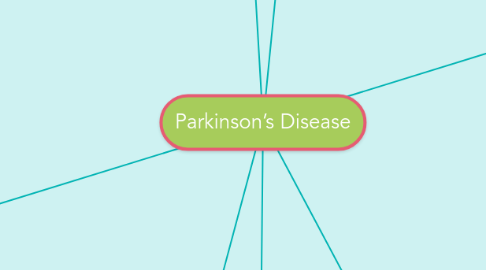
1. References:
1.1. Sommers, M. S., & Fannin, E. F. (2015). Diseases and disorders: a nursing therapeutics manual, parkinson’s disease (5th edition). Electronically published: F. A. Davis Company & Unbound Medicine, Inc.
1.2. Causes & Statistics. (2017, November 17). Retrieved November 19, 2017, from http://www.parkinson.org/Understanding-Parkinsons/Causes-and-Statistics
1.3. Galvan, A., & Wichmann, T. (2008, July). Pathophysiology of Parkinsonism. Retrieved November 19, 2017, from https://ww w.ncbi.nlm.nih.gov/pmc/articles/PMC2467461/
2. Signs & Symptoms
2.1. Signs
2.1.1. 3 Cardinal Signs
2.1.1.1. Involuntary tremors
2.1.1.2. Progressive muscle rigidity
2.1.1.3. Akinesia
2.1.2. Small handwriting
2.1.3. Loss of smell
2.1.4. Trouble sleeping or walking
2.1.5. Dizziness/fainting
2.2. Symptoms
2.2.1. 1st Symptom
2.2.1.1. Coarse, rest tremor of the fingers & thumb in one hand
2.2.1.2. Typically occurs at rest
2.2.2. 4 Important ones:
2.2.2.1. Tremors (resting)
2.2.2.1.1. Intensifies with:
2.2.2.1.2. Disappears with:
2.2.2.1.3. Occurs in:
2.2.2.1.4. If worsens, spreads to:
2.2.2.2. Bradykinesia
2.2.2.3. Cogwheel rigidity
2.2.2.4. Postural instability
2.2.2.4.1. Stooped posture
2.2.3. Onset typically asymptomatic
2.2.4. Weight loss
3. Etiology/Risk Factors
3.1. Family hx /Genetics
3.1.1. Autosomal recessive
3.1.1.1. PARK 1-9
3.1.1.2. PINK1
3.1.1.3. PRKN
3.1.2. Autosomal dominant
3.1.2.1. Rare: 1-2% with disease
3.1.2.2. SNCA
3.1.2.3. LRRK2
3.1.3. Mutated genes
3.1.3.1. HTRA2
3.1.3.2. LRRK2
3.1.3.3. NR4A2
3.1.3.4. NDUFV2
3.1.3.5. ADH3
3.1.3.6. FGF20
3.1.3.7. GBA
3.1.3.8. MAPT
3.1.4. Only 10-15% of incidence
3.1.5. Having 1st degree relative increases chances of developing disease
3.2. Environment
3.2.1. Live in rural area
3.3. Occupation
3.3.1. Head trauma
3.3.1.1. Traumatic brain injury
3.3.1.1.1. Alters LOC
3.3.2. Chemical exposure
3.3.2.1. Pesticides
3.3.2.1.1. Permethrin
3.3.2.1.2. Beta-hexachlorocyclohexane
3.3.2.2. Herbicide
3.3.2.3. Agent orange
3.3.2.3.1. 2,4-dichlorophenoxyacetic
3.3.3. Welders, farmers, military, industrial
3.4. Medication
3.4.1. Dopamine diminishing
3.4.1.1. Reserpine
3.4.1.2. Phenothiazine
3.4.1.3. Metoclopramide
3.4.1.4. Tetrabenazine
3.4.1.5. Butyrophenones
3.5. Idiopathic
4. Pathogenesis
4.1. Midbrain
4.1.1. Basal cell ganglia damage
4.1.1.1. Degeneration of substantia nigra
4.1.1.1.1. Lower dopamine uptake
4.1.1.2. Thalamus damage
4.1.1.3. Cortex damage
4.1.1.4. Abnormal firing of basal ganglia
4.1.1.5. Abnormal oscillatory neurons
5. Diagnostics
5.1. Positron Emission Tomography
5.1.1. Decreased uptake of dopamine in basal ganglia
5.2. Clinical Observation
5.2.1. Typically observed clinically because cannot perform exact diagnostic test due to no genetic marker
5.2.2. Pt. responds to levadrop
5.2.3. 2 of 4 symptoms must be present for diagnosis
5.2.3.1. Resting tremor
5.2.3.1.1. Must be 1 of 2 for diagnosis
5.2.3.2. Bradykinesia
5.2.3.2.1. Must be 1 of 2 for diagnosis
5.2.3.3. Cogwheel rigidity
5.2.3.4. Postural instability
5.2.4. Perform PROM
5.2.5. Observe pt. face
5.2.5.1. “Mask like”
5.2.5.2. Drooling
5.2.5.3. Expressionless
5.2.6. Orthostatic hypotension
6. Treatment
6.1. Medication:
6.1.1. Antiparkinson
6.1.2. Amantadine hydrochloride
6.1.3. Synthetic anticholinergics
6.1.4. Antihistamines
6.1.5. Medical marijuana
6.1.5.1. Cannabinoids
6.2. Therapy:
6.2.1. Physical
6.2.2. Speech
6.2.3. Occupational
6.2.4. Dietary
6.2.4.1. Nutrients
6.2.4.1.1. Small, frequent meals
6.2.4.1.2. Monitor weight
6.2.4.1.3. Vitamin C & E, Coenzyme Q10, Creatine, high monounsaturated fats/Omega-3 fatty acids, calcium
6.2.4.2. Risk for aspiration
6.2.5. Mental/psychological
6.2.6. Surgical
6.2.6.1. Only for pt. who have exhausted medication treatment
6.2.6.2. 2 options:
6.2.6.2.1. Deep brain stimulation (DBS)
6.2.6.2.2. Insert tube into small intestines to deliver levodopa
6.3. Ease cramping:
6.3.1. Warm bathes
6.3.2. Muscle massage
7. Incidence/Prevalence
7.1. In adults
7.1.1. Higher incidence in Hispanic/Latino and White/European populations
7.1.2. Higher in men (1.5x)
7.1.3. Global: 10-20 people per 100,000/yr
7.1.4. USA: 1% of population over 60 y/o
7.1.4.1. 60,000 diagnosed/yr
7.1.5. 15% develop dementia
7.2. In children
7.2.1. People younger than 40 y/o
7.2.2. Typically also have:
7.2.2.1. Wilson’s disease
7.2.2.2. Progressive lenticular degeneration
7.2.2.3. Huntington’s disease
